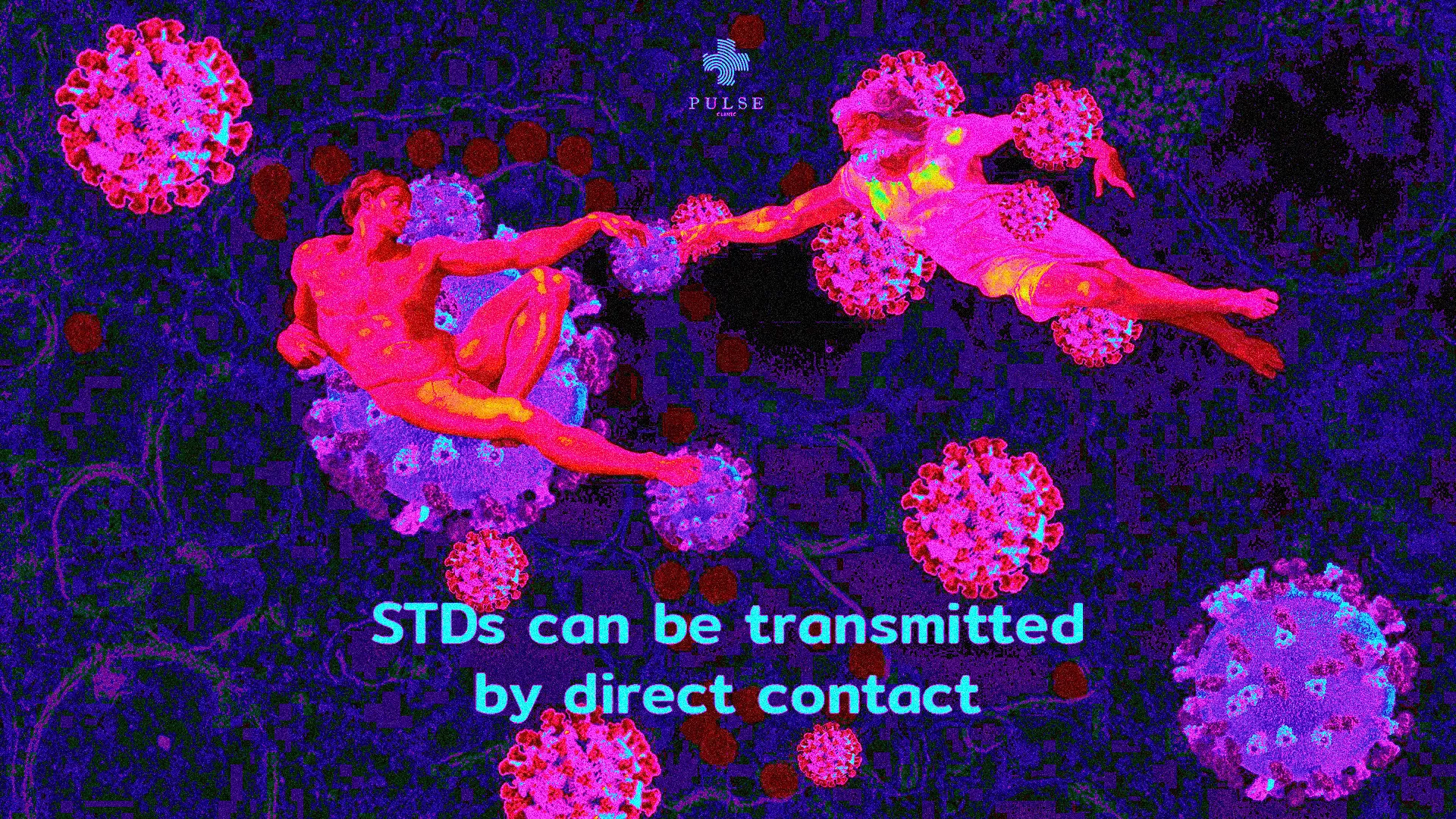Can Sexually Transmitted Infections Spread By Skin Contact?
18411
Skin-to-skin STDs are spread from one person to another by skin-to-skin contact and can be transmitted without intercourse.

Can Sexually Transmitted Infections Spread By Skin Contact?
Written by Dr.Natthakhet Yaemim (Dr.Deyn) Founding Director.
Last update: 2 March 2021
Common STDs Spread by Skin Contact
Several infections can be transmitted through skin-to-skin contact. The STIs that carry the highest risk of transmission through this type of contact include the following:
Genital and Oral Herpes
Herpes is an STD that many people worry about contracting through skin-to-skin contact. The virus can easily spread through contact with its highly contagious sores.
Most individuals with oral herpes are infected during childhood, often through casual interactions with family members. Both HSV-1 and HSV-2 can occur in either oral or genital forms, but HSV-2 is more commonly associated with genital infections.
Human Papillomavirus (HPV)
Both cancer-causing strains of HPV and those that lead to genital warts are easily transmitted through skin contact. Fortunately, there are vaccines available that can help prevent these infections.
Early HPV vaccination can protect against the most common cancer- and wart-causing strains. Ideally, vaccination should take place before individuals become sexually active, which is why it's recommended to start at age 11 or earlier, though it can still be administered later on.
Syphilis
There is increasing concern about the spread of this disease through contact with mouth sores during oral sex. Many people consider syphilis to be easily preventable, but the reality is more complex.
While condoms can help protect against transmission when sores are covered, sores in the mouth or on other areas of the skin may go unnoticed and untreated. These sores can still be contagious. This highlights the importance of testing, especially for high-risk groups.
Molluscum Contagiosum
This skin condition is commonly viewed as a childhood disease rather than an STD, but molluscum contagiosum sores can also be transmitted through sexual contact.
While the infection is usually painless, if the sores rupture, they can become infected with other bacteria. Therefore, it's important to consult a doctor about treatment options. Additionally, covering the sores can help prevent skin-to-skin transmission, as treatment can be challenging.
There is a High Risk of Infection
STDs are not necessarily transmitted every time people have sex, but they can spread rapidly. For example, if an infected person has unprotected sex with a new partner each year, and each of those partners does the same, the original person could potentially transmit the STD to over 1,000 individuals in just 10 years. If each person engages in sexual activity with two new partners annually, that figure can rise to more than 59,000.
What are STIs that mostly show no symptoms?
- Chlamydia (A-K)
- Chlamydia (L1-L3 that causes LGV)
- Trichomoniasis
- Herpes (is transmissible even when a person isn’t having an outbreak.)
- HPV (is transmissible even when a person isn’t having a warty lesion.)
- HIV (is transmissible even when a person isn’t having any symptoms.)
- Mycoplasma infections
- Ureaplasma infections
Add us on Line and stay in touch.
Does Safe Sex Guarantee Safety?
STIs that spread through skin-to-skin contact can be challenging to fully prevent with safer sex practices. This is because barriers like condoms may not cover all areas of potentially infectious skin. While condoms and other barriers can help prevent the transmission of STIs that are spread through bodily fluids, such as HIV and hepatitis, these infections are transmitted through contact with infected secretions like blood, semen, and vaginal fluids (the infectious secretions vary by disease). It's important to note that HIV is not transmitted through casual contact or skin-to-skin contact.
Screening Is Essential
The only way to know for certain if you or your partner has an STD is through testing. Before starting a new sexual relationship, both you and your partner should get tested for the most common STDs.
Practicing safer sex can help reduce the risk of skin-to-skin STI transmission from diseases like herpes and HPV. The more skin that is covered, the lower the chance that sores will come into contact with uninfected skin.
If you’re not comfortable visiting your regular doctor, you can also get tested at a family planning or STD clinic. Many of these clinics offer free or highly subsidized testing for individuals with limited incomes.
Even if your test results are negative, maintaining that status requires consistent practice of safer sex. Remember, it can take time for STD tests to provide accurate results. Additionally, having multiple sexual partners increases the risk of exposure.
What Kind of Screening Does PULSE CLINIC Offer?
PCR Multiplex DNA Test for 28 Infections 




Our STD PCR Multiplex test offers advanced technology to detect up to 28 infections, including Gonorrhea, Chlamydia, Syphilis, Herpes Simplex, Trichomonas, and Candida strains, all in one test. It can identify infections in various anatomical areas, such as the throat, urethra, anorectal region, vagina, cervix, sperm, and skin lesions. For urethral infections, the Urine PCR is recommended, while the Throat Swab PCR is ideal after oral sex. Anal Swab PCR is advised for unprotected anal sex, and the Vaginal Swab PCR is recommended for vaginal sex, with staff guidance available for all tests.
| PCR for 28 Infections (STD Multiplex) | Online results | |||
| Same day** | Next day | 3 days | 7 days | |
| Throat | 14,000 THB | 11,600 THB | 10,480 THB | 9,200 THB |
| Urine | 14,000 THB | 11,600 THB | 10,480 THB | 9,200 THB |
| Anal Swab | 14,000 THB | 11,600 THB | 10,480 THB | 9,200 THB |
| Vaginal Swab | 14,000 THB | 11,600 THB | 10,480 THB | 9,200 THB |
| Cervical Swab | 14,000 THB | 11,600 THB | 10,480 THB | 9,200 THB |
| Sperm | 14,800 THB | 12,640 THB | 11,600 THB | 10,080 THB |
| Skin Lesion Swab | 14,000 THB | 11,600 THB | 10,480 THB | 9,200 THB |
| Pooling | 15,600 THB | 13,280 THB | 12,400 THB | 10,800 THB |
| PCR for 2 Infections (Gonorrhea/Chlamydia) | Same day | Next day | 3 days | 7 days |
| Throat | 5,690 THB | 4,990 THB | 3,990 THB | 3,300 THB |
| Urine | 5,690 THB | 4,990 THB | 3,990 THB | 3,300 THB |
| Vaginal and Cervical Swab | 5,690 THB | 4,990 THB | 3,990 THB | 3,300 THB |
| Rectal Swab | 5,690 THB | 4,990 THB | 3,990 THB | 3,300 THB |
| Sperm* | 6,200 THB | 5,150 THB | 4,100 THB | 3,690 THB |
| Skin lesion Swab | 5,690 THB | 4,990 THB | 3,990 THB | 3,300 THB |
Contact us at info.bkk@pulse-clinic.com or chat on your preferred platform:
![]() +66 65 237 1936
+66 65 237 1936  @PULSEClinic
@PULSEClinic ![]() PulseClinic
PulseClinic
Add us on Line and stay in touch.
Loading...
Clinic Locations
Loading...


